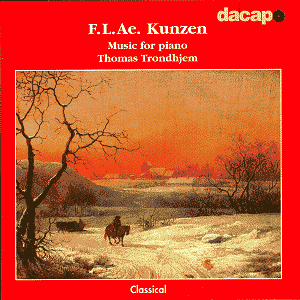This CD seems to consist
of the complete surviving music of the
Danish composer Fredrich Ludwig Aemilius
Kunzen. Apparently he was much more
prolific even composing Concertante
works and chamber music. Sadly none
of this survives. What there is dates
from before 1799 soon after which he
was made Master of the Royal Orchestra,
the highest academic position available
at the time in Denmark. Composing, as
a result, may well have dried up. However
until that point he had been a well
known and highly respected virtuoso
on the piano. At that time the piano
was riding a burgeoning wave of fame.
It was also becoming fashionable … especially
with young ladies. He was also a much
sought after teacher.
As one of my pupils
said in an essay "He (applied here,
but not originally, to Kunzen) came
from a family of musicians apart from
that he was quite normal"! Kunzen’s
father had played to and much impressed
no less than Handel. The family hailed
from Lübeck in Germany and was
held to be especially important in artistic
circles. Young Kunzen, like so many
composers, was sent to study law before
music took over.
Kunzen’s style could
easily be described as Haydnesque. Indeed
the Divertimento in A was once mistaken
for a work by the great man. However
I have to report that very little of
this music comes up as anything other
than mediocre Haydn. The best I can
say is that it makes pleasant if ephemeral
listening.
There is, mercifully,
an extensive and interesting booklet
essay by Heinrich Schwah which comes
to the rescue. It lists all of the sixteen
pieces known to have survived; others
may yet be found. It is not easy to
relate these to the pieces on the CD.
For example the list does not actually
mention ‘New Year pieces for the fairer
sex’ but only lists the individual items
separately. The first of the six pieces
is called ‘Theme and 10 Variations on
the aria "When I think of my Lene’"
which comes from ‘The Secret’ in B flat
major’. The Secret is a singspiel by
a composer not identified here. This
piece is listed as number eleven. The
third movement, a Minuet and Trio is
listed as number fourteen. The CD ends
rather curiously with a ‘Larghetto in
G major’ which at less than two minutes
is one of Kunzen’s most short-winded
efforts. It appears as number four in
the list. Surely it would have been
a good idea to end with one of the most
interesting works on the CD: the ‘Divertimento’
in A, which is helpfully subjected to
some close analysis in the booklet.
Although sixteen works
are here there are nineteen tracks.
This is in fact accounted for by the
four movement sonata. The Sonata is
very fine indeed. The only work on the
disc to fit that description. Apparently
it was one of several sonatas; more’s
the pity that it is the only one to
have survived. There are several things
about it to attract our particular attention.
First there is the unusual key of C#
minor. Indeed the work even ends in
C# major: that is, every black note.
With the old tuning system of the harpsichord
this would sound hideously out of tune;
with the unequal tuning of the modern
piano it becomes first a dark key and
then an especially bright one. Secondly
the sonata has four movements. The Scherzo
second and the slow movement third represent
a unique arrangement. Mozart never wrote
a four movement sonata and only one
survives in that form by Haydn. It seems
however that Kunzen had been transcribing
Haydn string quartets for piano some
of which (Op.20 no. 2 (1750)) do follow
this plan. Then there is the passion
and dramatic intensity of the music.
This is rather like Haydn’s ‘Sturm und
drang’ period or even C.P.E. Bach. It
is quite unlike the other music on the
CD. It was composed in Berlin where
C.P.E. had worked only twenty years
previously. Finally there is an unusual
approach to form - especially the Sonata
form opening movement which is monothematic;
a skill Mozart himself sometimes employed
(Sonata in Bb K281).
Here we have a composer
who could and did write in a serious
and contemporary style but who had to
write in a lighter one for the amateur
because he could guarantee publication,
performance and reputation. Unfortunately
with the one exception of the Sonata,
in the case of Kunzen, it is only this
latter music that has survived.
Thomas Trondhjem is
a new name to me but his biography is
given. He is a specialist in the classical
and Romantic schools. This shows in
his phrasing, ornamentation, subtle
pedalling and in the light and shade
in handling keyboard sonorities. I’m
only sorry that this music has not been
recorded on a fortepiano of the period;
the C# sonata would be especially interesting.
An ideal recording
with clarity yet atmosphere.
Gary Higginson
see also review
by Don Satz


